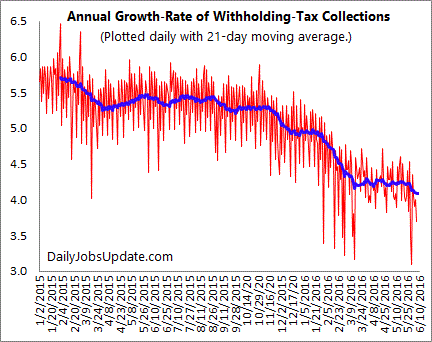The reaction after May’s disappointing jobs report was predictable: The candidates babbled, markets trembled and expectations that the Federal Reserve would raise rates this month or next was suddenly off the table. All of this because the net increase in a group of more than 150 million employed people was 0.02533 percent versus analysts’ estimates of 0.10533 percent. That’s before we account for either 35,000 workers out on strike (0.02333 percent) or the margin of error of 100,000 (0.06667 percent).
I have discussed the problems of trying to model the economy in real time too many times to detail here. But let’s not look at the employment situation. Instead, let’s consider some data involving actual dollars.
I was reminded of this by a recent article that noted that tax datashow that the job market is getting better, not worse.
The job market didn’t suddenly start sputtering over the past few months, as suggested by the surprisingly weak May employment report. Actually, the labor market has been getting stronger over the past several months after steadily losing steam last fall and then sinking with the stock market early this year. The latest data through Friday June 3 show that, over the previous four weeks, withheld taxes rose 4.7% from a year earlier, the fastest growth rate in seven months, an IBD analysis finds.
This is a compelling line of thought, based on taxes withheld from payrolls. This data is from the Bureau of the Fiscal Service of the Treasury Department, which releases daily information on collected receipts. What we see here isn’t consistent with the idea that employment growth is slowing, and instead suggests a modestly expanding labor market
A few caveats: First, this data isn’t seasonally adjusted; that means there are calendar effects, such as seasonality, annual or quarterly bonuses, and other issues that can skew it. Second, data on withheld taxes tells us little about the quality of those jobs being created. Last, tax cuts and increases also affect the numbers.
But it is hard data. The site Daily Jobs Update, run by Matt Trivisonno, tracks Treasury’s daily withheld tax revenue. Have a look at the chart created by the site showing monthly changes. It indicates a steady improvement during the past three months, and strong gains year over year.

Note this is cumulative, so it benefits from prior monthly gains in employment.
The second chart is a plot of the annual growth rate of withholding-tax collections (red line) with a 21-day moving average (blue line).

The chart reveals two things: First, the rate of growth in withheld taxes has been decelerating for the past 18 months; it was 5.5 percent in early 2015, and it’s now about 4 percent. That suggests a labor market that is maturing, and growing less rapidly than before. This is consistent with the idea that the economy is approaching full employment. This also jibes with the unfilled-jobs-opening data in the Job Openings and Labor Turnover Survey issued by the Bureau of Labor Statistics. As Trivisonno observes:
While this deceleration is similar to what we saw in 2008, it is much less steep. The Fed was trying to pop a real-estate bubble back then, but is far more dovish today. So, while the trend is clearly down, a 2008-style plunge seems unlikely without the Fed turning hawkish.
Second, 4 percent growth is still growth that, as Trivisonno notes, counts for a lot in a low-inflation environment.
The key takeaway is that last month’s nonfarm payroll gain of 38,000 was a noisy number, likely affected by one-time events. It may also have simply been one of those months when the model generated a weak reading. This month may be the opposite, with a large number of new jobs. If that happens, it might be equally misleading. The bottom line is that it is premature to declare this economic expansion dead, and a recession imminent. As the data on tax withholding suggest, the economy is still expanding at a good clip.
Originally: Job Market Is Getting Stronger, Not Weaker


What's been said:
Discussions found on the web: